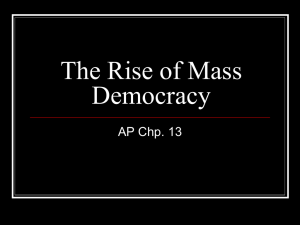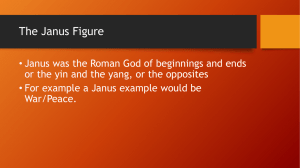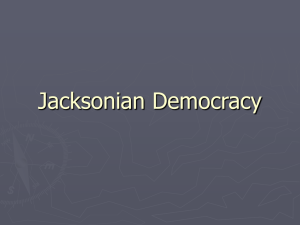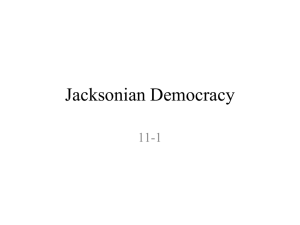chapter 12 - Crestwood Local Schools
advertisement
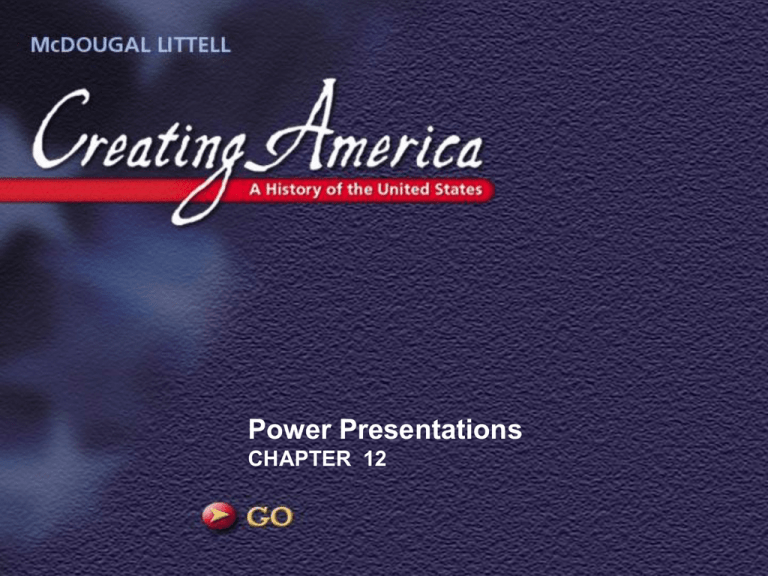
Power Presentations CHAPTER 12 Economics in History Image The year is 1828. You will vote for president for the first time. Important economic, social, and political issues face the country. The favored candidate is Andrew Jackson, a military hero. Before you vote, you should decide what qualities make a strong leader. What qualities do you think make a strong leader? • Which earlier presidents would you consider strong leaders and which not? • Would qualities that make a military leader also make a good president? Why or why not? 1824 John Quincy Adams is elected president. 1828 Tariff of Abominations signed into law. Andrew Jackson is elected president. 1830 Indian Removal Act is passed. 1832 Jackson vetoes charter of Bank of the United States. South Carolina nullifies tariffs. Jackson is reelected. 1836 Martin Van Buren is elected president. To World 1838 Cherokees begin to travel the Trail of Tears. 1840 William Henry Harrison is elected president. Image 1824 Simón Bolívar becomes president of Peru. 1830 Revolutions occur in Belgium, France, and Poland. 1832 Reform Act increases number of voters in Britain. 1837 Victoria becomes queen of Great Britain. 1838 Zulu clash with Boer settlers in South Africa. Back to U.S. Back to Home Main Idea Andrew Jackson’s election to the presidency in 1828 brought a new era of popular democracy. Why It Matters Now Jackson’s use of presidential powers laid the foundation of the modern presidency. What are important facts to know about Andrew Jackson’s life? LIFE OF ANDREW JACKSON Youthful Life frontier farm, prisoner in Revolutionary War, wild and reckless Road to Congress lawyer in Tennessee, bought and sold land, elected to Congress War Hero defeated British in Battle of New Orleans Appeal to voters humble background, military hero, defender of common people • How did Andrew Jackson react to the election of 1824? Why? • What factors helped Jackson win the presidency in 1828? • What was the effect of expanding voting rights? Analyzing Points of View What are reasons for and against the spoils system? Think About • the effects of giving government workers lifetime jobs • the effects of rewarding political supporters Back to Home Main Idea During Jackson’s presidency, Native Americans were forced to move west of the Mississippi River. Why It Matters Now The forced removal forever changed the lives of Native Americans in the United States. Map What were the reasons for Jackson’s Native American removal policy? Image REASONS NATIVE AMERICANS WERE FORCED WEST Economic Political Social white settlers and miners wanted their land Native Americans could not legally maintain independent governments within the United States many whites considered them uncivilized • How did President Jackson justify the Indian Removal Act? • In what ways did Native Americans resist the Indian Removal Act? • What were the consequences of the Indian Removal Act? Recognizing Effects What were some economic effects of the Indian Removal Act on Native Americans? On whites? Think About • what the Native Americans lost • what the white settlers gained Back to Home Main Idea Jackson struggled to keep Southern states from breaking away from the Union over the issue of tariffs. Why It Matters Now Disputes about states’ rights and federal power remain important in national politics. How did the Northeast, the West, and the South stand on the issues of the sale of public lands, internal improvements, and high tariffs? Northeast West South Sale of public lands for against no discussion in text Internal improvements for for against High tariffs for no discussion in text against • Why did the South oppose high tariffs? • What were Calhoun’s reasons for proposing the doctrine of nullification? • Why did South Carolina threaten secession, and how was the crisis resolved? Recognizing Effects In what ways would the doctrine of nullification have made it difficult for the federal government to operate? Think About • its effect on the enforcement of laws • its effect on the power of the federal government Back to Home Main Idea Jackson’s policies caused the economy to collapse after he left office and affected the next election. Why It Matters Now The condition of the economy continues to affect the outcomes of presidential elections. What events led to the closing of the Second Bank of the United States? Event 1: Biddle asks Congress to renew charter in 1832 Event 2: Congress renews charter Event 4: Jackson reelected Event 5: Jackson deposits federal funds in pet banks Event 3: Jackson vetoes charter Bank Closes • Why did Jackson declare war on the Second Bank of the United States? • How did Jackson kill the bank? • What role did Jackson’s popularity play in the elections of 1836 and 1840? Comparing What strategy did the Whig Party use in the 1840 election? Think About • how Harrison was portrayed • what group of voters it was trying to attract Back to Home REVIEW QUESTIONS ANSWERS: READ AND TAKE NOTES 1 How was Jackson different from earlier presidents? 2 How did Jackson appeal to voters in his election campaign of 1828? 3 Why did white settlers want Native American land? 4 What was Jackson’s position on Native Americans in the United States? 5 How did the Indian Removal Act affect Native Americans? 6 How did the issue of tariffs divide the country? 7 Why did nullification threaten the nation? 8 How was the nullification crisis resolved? 9 Why did Jackson oppose the Second Bank of the United States? 10 What were the effects of Jackson’s war on the bank? Changes During Jackson’s Presidency Political • Democratic and Whig parties formed • common people given voice in government • spoils system created • Union strengthened Economic • higher tariffs enacted • national bank closed • inflation grew Social • common people had more importance • Native Americans removed to the West • whites settled on former Native American lands Back to Home These labels let you know where you are in the presentation. When you click on the arrow you will be linked to a related visual. Map Image These buttons link you to special areas. Use these buttons to go back to the previous slide, or to move forward in the presentation. To reveal the content of a slide just press the space bar or click your mouse once. To use a button, move your pointer over the button. When your pointer becomes a hand, click your mouse. Back to Previous




